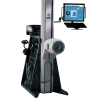
7 Pillars of Clinic Management for OT and PT
Practice ManagementWhether you’re a seasoned clinic manager or newly stepping into the role, these insights will help you create the best outcomes in your rehabilitation clinic. We’ll explore concise strategies and new innovations that will help you succeed, from staff management to reimbursement and more.
Clinic management is a role that requires wearing many hats, from managing the business to ensuring high-quality patient care, and everything in between. This guide delves into the nuances of streamlining OT and PT clinic operations, creating a positive work environment, and enhancing patient care. Whether you’re a seasoned clinic manager or newly stepping into the role, these insights will help you create the best outcomes in your rehabilitation clinic. We’ll explore concise strategies and new innovations that will help you succeed.
Managing a clinic requires a diverse skillset. Your clinical degree program prepared you well for a career as a practitioner, but learning to manage a clinic is another field entirely. Here we will cover seven pillars of success for clinic management in physical therapy and occupational therapy:
- Staff management
- Hiring new staff
- Preventing burnout
- Clinic management software
- How to choose the right one for your clinic
- Telehealth platforms
- Evidence-based clinical technology
- Expectations of today’s patients
- Data-driven rehab: measuring, reporting, and tracking progress
- Elevate your evaluations and treatment with objective tools
- Clinic marketing
- Building a marketing strategy that works
- Patient engagement
- Improving patient engagement in five steps
- Billing and reimbursement
- Overview of reimbursement process
- Documentation
- CPT codes and reimbursement
- Challenges and denied claims
- Regulatory and compliance
- HIPAA and privacy
- Medicare and Medicaid compliance
- Private insurance regulations
- State licensing
1. Staff Management
Your staff are your clinic’s backbone. Having a motivated, cohesive team helps your clinic succeed. From hiring the right clinicians to promoting workplace wellness and preventing burnout, a well-developed staff management strategy is essential to your clinic management overall.
Hiring New Staff
For both Occupational Therapists and Physical Therapists, the average clinician stays at their job for just one to two years (43% of OTs, and 31% of PTs). The second largest tenure category is less than one year, for 19% of OTs and 28% of PTs.1 With this relatively high turnover rate, you must be ready to hire new clinical staff with minimal downtime.
Whether you’re replacing due to turnover or expanding your clinic, bringing on new staff is an exciting time. To help you find the right fit, check out this article: Five Interview Questions for New Candidates. Once you’ve hired the new member of your team, help them get acquainted with your current staff and feel welcome in your clinic. Holding regular one-on-ones with them will help you track their progress and gives them the opportunity to ask for help when needed. Plus, you may find a newcomer’s perspective very helpful in identifying areas of improvement for your clinic.
Preventing Burnout
On the other end of the spectrum is preventing employee burnout. Burnout is a major concern for staff Occupational Therapists and Physical Therapists, as the bar for today’s productivity demands is generally set high. This can be dangerous, as often, burnout results in decreased productivity, low job satisfaction, and turnover. Here are four ways to mitigate burnout by promoting a healthy work environment in your clinic:
- Manage workloads – Ensure that workloads are reasonable. To maximize productivity, it can be tempting to load up your staff with as many patients as possible. But chronic overscheduling leads to overburdened staff who will seek a more manageable work environment elsewhere.
- Time off and breaks – Encourage staff to use their time off and vacation time. Time away from work is essential for mental and physical health.
- Mental health support – Be attentive to signs of stress or disengagement and provide a safe space for discussing these issues and finding solutions.
- Recognition – Regularly recognize and reward your staff’s hard work. Simple verbal appreciation, bonus programs, or professional development opportunities can go a long way in boosting morale.
2. Clinic Management Software
Clinic management software helps your practice run smoothly and efficiently. The right software will streamline your appointment scheduling, billing, patient records, and much more. With so many clinic management software options on the market, it can be hard to evaluate all the options. Here we’ll cover a few key criteria to guide your decision process and find the right clinic management software for you:
- Your clinic’s needs, including patient volume, specialty services, staff size, and integration with existing EHR or billing systems.
- User-friendliness
- Features and applications
- Customization and scalability
- Support and training
- Cost and ROI
How To Choose the Right Clinic Management Software
It’s smart to start by identifying the needs of your clinic. Do you serve a high volume of patients daily, or is your practice more boutique? Do you offer any specialized services that would require specific features in the software? How many employees will use it? Does it need to integrate with existing systems like your EHR, or billing software? Integration with your existing systems can help streamline processes and reduce data entry redundancy.
Most modern clinic management software will have a well-designed user interface. Still, it’s worth signing up for a demo so your staff can see if it works for them. A user-friendly experience is vital. Intuitive operations will reduce the learning curve, save time, and minimize errors.
In order to meet the needs you identified, your clinic management software should include a range of features and applications. These include appointment scheduling, billing and invoicing, patient records, reporting and analytics, and data security (including HIPAA compliance). Each of these features is important to ensuring smooth management of your clinic’s essential functions.
Customization and scalability are how you build for the future. Flexibility is key. Do you plan to add new services or expand your clinic? Choose software that can be tailored to your workflow and can be changed as your clinic develops. This ensures that the software can adapt to your needs, not the other way around.
As with any new tool, a new clinic management software will require some training. Look for an option that includes robust training videos, live sessions, or on-demand courses. In addition to learning the new system, you’ll want to ensure continued support. The level of support may vary between software companies and the packages they offer. Look for support options including phone, email, live chat, help articles, and a user community forum. Quick customer support can save you time and frustration when issues arise.
Finally, consider the cost of the software and how it contributes to the success of your clinic. While cost is a significant factor, keep in mind that investing in efficiency can save time and money in the long run. By considering these factors, you can be confident in choosing a clinic management software that enhances your operations, simplifies your workflow, and contributes to a high standard of care.
How To Choose a Telehealth Platform
The COVID-19 pandemic pushed many rehabilitation clinics to explore telehealth. While it may sound counter-productive for occupational therapy or physical therapy services, many providers are finding creative, new ways to help their patients remotely.
Choosing a telehealth platform requires careful consideration. The best one for your clinic depends on the needs of your clinic and severable variable features of the software itself. When choosing a telehealth platform, start with a quick needs assessment of your clinic. Use the following points to evaluate your clinic’s needs:
- Monthly patient volume
- Clinical users
- How many clinicians need access?
- What are their clinical disciplines? Only PTs or OTs, or both or more?
- Specialty services offered at your clinic, such as hand therapy, workers’ comp, and more
- Existing EHR and other software
Next, you’ll want to compare features and benefits of the telehealth platforms you’re considering. That includes HIPAA and reimbursement requirements, user-friendliness, training, and tech support. For more help on finding the right fit for your clinic, read How To Choose a Telehealth Platform.
3. Evidence-Based Clinical Technology
Staying up-to-date with the latest clinical technology is not just an option, but a necessity. Integrating technology into your treatment and evaluation significantly elevates your standard of care. However, it’s important to strike a balance between investing in new technology and resisting the temptation to buy each new gadget and gizmo that hits the market. Let’s discuss the ways you can harness technology to provide a higher level of care, boost patient engagement, and drive better outcomes.
Expectations of Today’s Patients
As healthcare costs rise, patients increasingly expect more from their clinic visits. In other words, if you want to prevent attrition, you have to provide a valuable experience at every session. Simple rubber band exercises may be effective in the short-term, but how long until the patient becomes disengaged and decides they can do these same activities without you?
Your clinic needs to offer valuable treatment that patients not only appreciate, but eagerly return to. Utilizing technology is a strategic way to meet these expectations and demonstrate your commitment to high-level care. Look for treatment technology that is engaging or gamified to keep patients interested and motivates them to continue with their sessions.
Data-Driven Rehab: Measuring, Reporting, and Tracking Progress
Objective measurement is a game-changer in clinical evaluations and treatment. Technology that allows you to measure, track, and report progress over time will demonstrate the difference your treatment makes. Rather than relying on the subjective nature of MMT or self-reporting, objective data shows patients exactly how they are progressing.
Objective progress reports make a strong impression to everyone involved in care, including patients, referrers, and case managers. When referring doctors see charts and graphs detailing improvement in strength and range of motion, they immediately understand the value of your treatment.
“The objective data clearly shows patient progress and evidence for our recommendations. It’s a terrific marketing tool that helps us get more referrals,” says Rich Douglas, Center Manager of NovaCare Rehabilitation. He uses objective data as a motivational tool for patients and referrers. See how NovaCare keeps clients engaged and shows real proof of progress with objective reporting in this case study.
Elevate Your Evaluations and Treatment with Objective Tools
BTE provides the world’s leading clinical technology for both evaluations and treatment. Our systems are highly engaging and evidence-based to bring better outcomes for your patients and your business. With BTE systems in your clinic, you’ll provide a higher standard of care that meets and exceeds expectations. Explore our product lines for both Functional Rehabilitation and Evaluation and Testing.
4. Clinic Marketing
Marketing is one of the many skills that clinic managers usually have to learn through experience. That’s why we created this guide: Everything You Need To Build a Clinic Marketing Strategy. In it, we cover everything from how to identify your audience (hint: it’s not just people in the area with certain injuries) to navigating the ever-changing world of Search Engine Optimization (SEO) and Search Engine Marketing (SEM).
Marketing campaigns that resonate in a genuine way will strengthen your patient relationships and help grow your clinic. Whether you’re opening a new practice or looking to breathe new life into a longstanding clinic, these marketing activities will get you to your goals. Learn how to create a clinic marketing strategy including content marketing, website development, digital ads, online reviews, trackable performance metrics, and more.
Read our complete guide to clinic marketing: Everything You Need To Build a Clinic Marketing Strategy.
5. Patient Engagement
As a clinic manager, you already know that high levels of patient engagement can decrease dropouts, drive better clinical outcomes, generate referrals, and contribute to your clinic’s overall success. Studies show that patients who are more actively involved tend to have better outcomes.2 In addition to the patient benefits, high engagement also supports your business by encouraging positive word-of-mouth and reviews. As 92% of people trust recommendations from people they know, it’s vital to provide the best patient experience possible.3
Improve Patient Engagement in Five Steps
So how do you improve patient engagement at your clinic? These five steps are the perfect place to start:
- Define your clinic’s vision for patient engagement
- Create a culture of engagement
- Employ the right technology and services
- Empower patients to become collaborators in their care
- Chart progress and modify as necessary4
Supporting patient engagement takes input from every role in your clinic, not just the clinical staff. Many of the tactics you’ll use to drive engagement will benefit your patients, staff, and business in more ways than one.
First, you should seek input from your staff. Hold feedback sessions to learn what helps, what gets in the way, and how you can make improvements. Set your goals as a team to encourage collaboration and buy-in from everyone. Creating a culture of engagement means making every touchpoint patient-centered. Your clinical staff should know how to actively listen, educate patients, personalize each session, and involve family / caregivers when necessary.
The right technology can help make the patient experience better than ever. From booking to billing and even session progress, your clinic should take advantage of software that saves you time and keeps patients engaged.
In another article, we dive into each of these five steps and show you how to apply this process at your clinic. You’ll learn simple tactics you can start today plus long-term strategies for success. Read it now: 5 Steps to Better Patient Engagement.
6. Billing and Reimbursement
Now let’s dive into one of the trickier aspects of clinic management: billing and reimbursement. This process ensures you get paid for the services you provide. But like many things in healthcare, the landscape is complex and evolving. Here’s a quick overview of the billing and reimbursement process in a typical rehab clinic.
Overview of the Billing and Reimbursement Process
First, the clinician provides documentation on the patient visit. This will include details of the treatments, exercises, patient progress, and any changes to the plan of care. These services are associated with a specific CPT (Current Procedural Terminology) code which determines how it is billed.
Second, the clinic creates a bill and submits to the payer for review. The bill includes the diagnosis, a breakdown of all services provided, the corresponding CPT codes, and other relevant information. The bill is submitted to a payer, usually an insurance company or Medicare / Medicaid.
Third, the payer will evaluate the bill and determine whether the documentation justifies payment. If it is approved, the bill we be paid. If it’s denied, the clinic will receive notice. Most of the time, a denial can be resolved by correcting the documentation or providing further information required by the payer. More on each of these three parts next.
Documentation
Detailed documentation is paramount to billing and reimbursement. Typically, documentation should start with the patient information and medical history. From there, the treatment plan should present a logical and relevant approach to each activity or intervention used. Throughout the sessions, it’s best to use objective measurements to show progress over time. This could include range of motion, strength assessments, pain scales, and any other quantifiable data.
When documenting a specific treatment exercise, the notes should include the following:
- Timing
- Supervision
- Exercise volume (exact sets, reps, weight, etc.)
- Progress with this exercise over time
CPT Codes and Reimbursement
Whether you’re documenting an evaluation, exercise, manual intervention, or other treatment procedure, there’s a CPT code for that. Payers will evaluate the documentation against the set criteria for each code. It’s important to understand the requirements for CPT codes to maximize reimbursement while remaining compliant. More on that here: The 3 Most Common CPTs in Rehab.
Challenges and Denied Claims
With thorough documentation and compliant practices, you should have no issues with reimbursement. However, you may get a denial every once in a while. Claims can be denied for various reasons. When a claim is denied, you must investigate the reason and appeal the denial.
Most of the time, it’s a documentation issue. Your clinical staff may rarely deal with billing, but it’s important that they understand the requirements of their documentation. If a claim has been denied, take a look at the documentation and check for the following:
- Exactly what exercises the patient performed and why
- How long the exercise lasted (and how many billable units)
- Who supervised the exercise (PT, PTA, etc.)
- How the patient has improved over time in terms of volume or intensity
Overall, the more detail you provide, the better. Claims reviewers will be checking off their list of requirements while they read your documentation. Provide as much information as possible to ensure your claims get approval.
7. Regulatory and Compliance
As a clinic manager, you don’t just oversee patient care and business operations. You’re also responsible for navigating the complexities of regulatory and compliance requirements of the practice. Understanding and managing these issues can be challenging, but is essential to running your practice. This topic deserves its own series of articles to cover everything a clinic manager needs. But for now, we will cover four core regulatory and compliance concerns that clinic managers must prioritize: HIPAA, Medicare and Medicaid, state licensing, and insurance regulations.
HIPAA Compliance and Patient Privacy
First, one we’re all familiar with: HIPAA compliance. The Health Insurance Portability and Accountability Act is a cornerstone of healthcare regulation. HIPAA regulations protect patients’ health information and ensure confidentiality.5 Clinics handle sensitive health information regularly, so adherence to HIPAA is non-negotiable. In order to stay compliant, clinics should:
- Secure patient information – Keep records and data safe from unauthorized access or breaches. This includes securing physical records, electronic records, and communication channels. Any software or platform that you use to handle patient information should have built-in security measures.
- Train your staff – Ensure your staff is educated on HIPAA compliance, data security, and the importance of confidentiality. New hire training is the perfect opportunity to provide this information.
- Implement proactive policies – Establish and enforce HIPAA-compliant policies that govern how patient information is handled, stored, and shared.
For more information, visit the US Department of Health and Human Services’ website specifically for HIPAA compliance.
Medicare and Medicaid Compliance
If your clinic works with Medicare and Medicaid beneficiaries, you must comply with an additional set of regulations. The Centers for Medicare and Medicaid Services (CMS) enforces certain requirements on clinics billing for reimbursement. Key requirements include:
- Eligibility and enrollment – In order to treat Medicare or Medicaid patients, your clinic must be enrolled in CMS’ program. This is a multi-step process that involves meeting certain eligibility requirements and submission for acceptance. Medicare and Medicaid have separate but similar requirements. For more information on Medicare eligibility, visit the Medicare Enrollment Guide for Providers.6 Visit your state’s Medicaid site for more information on provider eligibility requirements.
- Billing Accuracy – This is not only a financial responsibility, but a legal requirement. Mistakes or inaccuracies can lead to improper payments, claims denials, or even investigations for fraud.
- Documentation – This one almost goes without saying, but it is absolutely essential to running your practice. Medicare and Medicaid require detailed documentation and record keeping, including patient records and services provided.
- Beneficiary rights – Medicare and Medicaid patients (beneficiaries) have specific rights defined by the respective agencies. These rights include informed consent and the right to choose their provider.6 More information on Medicare beneficiary rights can be found here, and you can find more information on Medicaid rights on your state’s site.
- Ongoing education – Ensure compliance by continually educating your staff on the matter. Regular training and education will help keep your providers up to date. You may also want to occasionally audit your billing and documentation practices to preemptively address any potential issues.
- Adapt to changes – These regulations are subject to change. Clinic managers must stay informed of these updates and adapt your practices accordingly. One way to stay informed is to subscribe to email updates from the CMS blog or other helpful resources, like us here at TherapySpark.
Private Insurance Regulations
Like Medicare and Medicaid, private insurance companies issue their own requirements. In order to become an in-network provider for a particular insurance company, your clinic must undergo credentialing and adhere to contract terms and the payer’s regulations. These include prior authorization requirements, medical necessity criteria, benefit verification, claims documentation stipulations, and other compliance considerations.
As you may have noticed, many of these regulations overlap. Often, what is required for Medicare and Medicaid also meets the criteria for other payers and vice versa.
7. State Licensing
Last but not least, state licensing. Each state has its own regulatory board responsible for regulating providers’ licenses. Your clinical staff are responsible for maintaining their licenses and continuing education requirements. However, some clinic managers offer continuing education opportunities in-house.
While physical therapy and occupational therapy license requirements are state-specific, some states are working together to allow individuals to practice in multiple states (*APTA, OT Compact). Known as a compact, this agreement would give practitioners greater flexibility and reach. For more information and updates as states join the compact, visit OT Compact and APTA Licensure Compact.7,8
Conclusion
As we’ve seen, clinic management encompasses many different areas of business and clinical expertise. Depending on the size and structure of your clinic, you may be able to delegate some of these responsibilities or hire an external resource for help. Mastering these skills and developing effective clinic management practices takes a blend of skill, innovation, and continuous learning. The insights discussed here can guide you towards operational excellence and enhanced patient care. Expanding your clinic management skillset helps you create an environment where excellence, adaptability, and commitment to health are at the forefront, bringing a brighter future for your patients and your practice.
Colleen Isaiah
Editor, TherapySpark
BTE





